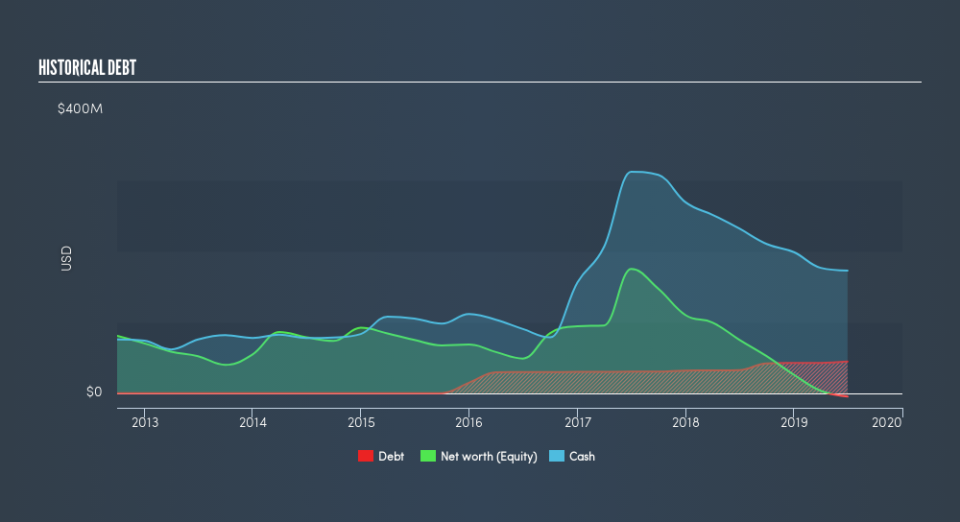Is Cytokinetics (NASDAQ:CYTK) Using Too Much Debt?

Howard Marks put it nicely when he said that, rather than worrying about share price volatility, 'The possibility of permanent loss is the risk I worry about... and every practical investor I know worries about.' So it might be obvious that you need to consider debt, when you think about how risky any given stock is, because too much debt can sink a company. As with many other companies Cytokinetics, Incorporated (NASDAQ:CYTK) makes use of debt. But should shareholders be worried about its use of debt?
What Risk Does Debt Bring?
Debt and other liabilities become risky for a business when it cannot easily fulfill those obligations, either with free cash flow or by raising capital at an attractive price. Ultimately, if the company can't fulfill its legal obligations to repay debt, shareholders could walk away with nothing. However, a more frequent (but still costly) occurrence is where a company must issue shares at bargain-basement prices, permanently diluting shareholders, just to shore up its balance sheet. Of course, the upside of debt is that it often represents cheap capital, especially when it replaces dilution in a company with the ability to reinvest at high rates of return. The first step when considering a company's debt levels is to consider its cash and debt together.
View our latest analysis for Cytokinetics
How Much Debt Does Cytokinetics Carry?
As you can see below, at the end of June 2019, Cytokinetics had US$44.5m of debt, up from US$32.4m a year ago. Click the image for more detail. However, its balance sheet shows it holds US$172.9m in cash, so it actually has US$128.4m net cash.
How Healthy Is Cytokinetics's Balance Sheet?
The latest balance sheet data shows that Cytokinetics had liabilities of US$22.0m due within a year, and liabilities of US$181.2m falling due after that. On the other hand, it had cash of US$172.9m and US$9.57m worth of receivables due within a year. So it has liabilities totalling US$20.7m more than its cash and near-term receivables, combined.
Of course, Cytokinetics has a market capitalization of US$824.4m, so these liabilities are probably manageable. Having said that, it's clear that we should continue to monitor its balance sheet, lest it change for the worse. While it does have liabilities worth noting, Cytokinetics also has more cash than debt, so we're pretty confident it can manage its debt safely. The balance sheet is clearly the area to focus on when you are analysing debt. But ultimately the future profitability of the business will decide if Cytokinetics can strengthen its balance sheet over time. So if you want to see what the professionals think, you might find this free report on analyst profit forecasts to be interesting.
In the last year Cytokinetics managed to grow its revenue by 102%, to US$36m. So there's no doubt that shareholders are cheering for growth
So How Risky Is Cytokinetics?
Statistically speaking companies that lose money are riskier than those that make money. And in the last year Cytokinetics had negative earnings before interest and tax (EBIT), truth be told. And over the same period it saw negative free cash outflow of US$97m and booked a US$110m accounting loss. But at least it has US$173m on the balance sheet to spend on growth, near-term. Importantly, Cytokinetics's revenue growth is hot to trot. High growth pre-profit companies may well be risky, but they can also offer great rewards. For riskier companies like Cytokinetics I always like to keep an eye on the long term profit and revenue trends. Fortunately, you can click to see our interactive graph of its profit, revenue, and operating cashflow.
At the end of the day, it's often better to focus on companies that are free from net debt. You can access our special list of such companies (all with a track record of profit growth). It's free.
We aim to bring you long-term focused research analysis driven by fundamental data. Note that our analysis may not factor in the latest price-sensitive company announcements or qualitative material.
If you spot an error that warrants correction, please contact the editor at editorial-team@simplywallst.com. This article by Simply Wall St is general in nature. It does not constitute a recommendation to buy or sell any stock, and does not take account of your objectives, or your financial situation. Simply Wall St has no position in the stocks mentioned. Thank you for reading.

